
Hieracium , known by the common name hawkweed and classically as hierakion, is a genus of flowering plant in the family Asteraceae, and closely related to dandelion (Taraxacum), chicory (Cichorium), prickly lettuce (Lactuca) and sow thistle (Sonchus), which are part of the tribe Cichorieae. Hawkweeds, with their 10,000+ recorded species and subspecies, do their part to make Asteraceae the second largest family of flowering plants. Some botanists group all these species or subspecies into approximately 800 accepted species, while others prefer to accept several thousand species. Since most hawkweeds reproduce exclusively asexually by means of seeds that are genetically identical to their mother plant, clones or populations that consist of genetically identical plants are formed and some botanists prefer to accept these clones as good species whereas others try to group them into a few hundred more broadly defined species. What is here treated as the single genus Hieracium is now treated by most European experts as two different genera, Hieracium and Pilosella, with species such as Hieracium pilosella, Hieracium floribundum and Hieracium aurantiacum referred to the latter genus. Many members of the genus Pilosella reproduce both by stolons and by seeds, whereas true Hieracium species reproduce only by seeds. In Pilosella, many individual plants are capable of forming both normal sexual and asexual (apomictic) seeds, whereas individual plants of Hieracium only produce one kind of seeds. Another difference is that all species of Pilosella have leaves with smooth (entire) margins whereas most species of Hieracium have distinctly dentate to deeply cut or divided leaves.
A dry roadside dotted with small, ¾ inch red orange flowers, interspersed with very similar yellow ones, and often the white of daisies, is a good sign that you are in Hawkweed country.

Hieracium lachenalii, also known as common hawkweed or yellow hawkweed, is a species of plant in the tribe Cichorieae within the family Asteraceae. It is native to Europe but has become established as a weed in Australia and parts of North America. The species was widely known for many years as H. vulgatum, but more recent studies have indicated that the two names represent the same species. The name H. lachenalii was coined in 1802, H. vulgatum in 1819, so the older name is to be used.

Pilosella caespitosa is like several other Pilosella species and has a similar appearance to many of the hawkweeds.

Hieracium albertinum, known as western hawkweed or houndstongue hawkweed, is a species of the genus Hieracium that is very similar to Hieracium albiflorum with white flowers but differs in that the flower heads are clustered and the leaves, stems and bracts are covered in a thick layer of hairs. Standing 1 inch (3 cm) to 5 inches (13 cm) tall, it can be found blooming from June through August in forest clearings.
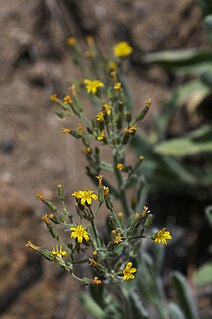
Pilosella horrida, known as the prickly hawkweed or shaggy hawkweed, gets its name from the long, dense, shaggy white to brown hairs (trichomes) which cover all of the plant parts of this plant species. The species is native to Oregon, California, and Nevada in the western United States.
Hieracium greenei is a species of hawkweed known by the common name Greene's hawkweed.
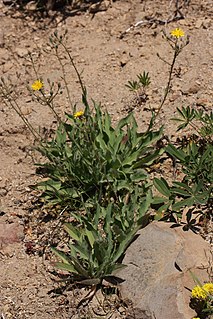
Pilosella scouleri is a North American species of flowering plant in the tribe Cichorieae within the family Asteraceae. It is known as Scouler's woollyweed. It is native to western North America, from British Columbia and Alberta in Canada, south to northern California and Utah in the United States.
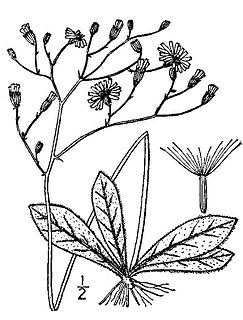
Hieracium venosum is a species of hawkweed in the tribe Cichorieae within the family Asteraceae. It is widespread and common in south-central Canada (Ontario) and the eastern United States. Its common name comes from the fact that environments it is found in are typically also a home to rattlesnakes.

Hieracium piloselloides is a species of flowering plant in the family Asteraceae known by the common name tall hawkweed. It is native to Europe and it is present in North America as an introduced species and a common weed.
Hieracium carneum, common name Huachuca hawkweed, is a North American plant species in the family Asteraceae, native to Arizona, New Mexico, Texas and Chihuahua. It grows on rocky sites at elevations of 2,000–2,300 m (6,600–7,500 ft).
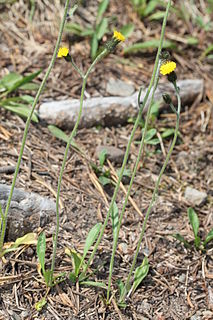
Pilosella tristis is a North American species of flowering plant known by the common name woolly hawkweed. It is widespread across western Canada and the western United States from Alaska, Yukon, and Northwest Territories south as far as California and New Mexico.

Hieracium traillii is a species of hawkweed known by the common name Maryland hawkweed.
Pilosella abscissa is a plant species in the tribe Cichorieae within the family Asteraceae. It is considered to be native to the southwestern United States, Mexico and Central America.
Hieracium bolanderi or Bolander's hawkweed is a North American plant species in the tribe Cichorieae within the family Asteraceae. It is found primarily in the mountains of western Oregon and northern California in the United States, although there are reports of the species farther south in the San Bernardino Mountains in southern California and also in Baja California in Mexico.
Pilosella flagellaris is a European plant species in the tribe Cichorieae within the family Asteraceae. It is native to Europe but naturalized in scattered locations in the United States and Canada.
Hieracium longiberbe, known by the common name longbeard hawkweed, is a rare North American plant species in the tribe Cichorieae within the family Asteraceae It has been found only in the Columbia River Gorge along the border between the states of Washington and Oregon in the northwestern United States.
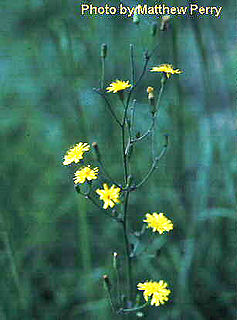
Hieracium paniculatum, the Allegheny hawkweed, is a North American plant species in the tribe Cichorieae within the family Asteraceae. It grows only in the eastern United States and eastern Canada, from Nova Scotia west to Ontario, Michigan, and Indiana south as far as Georgia.
Hieracium pringlei, common name Pringle's hawkweed, is a North American plant species in the tribe Cichorieae within the family Asteraceae. It is native to Mexico with additional populations in Guatemala, Arizona, and New Mexico.

Hieracium scabrum, the rough hawkweed, is a North American plant species in the tribe Cichorieae within the family Asteraceae. It is native to eastern and central Canada and the eastern and central United States from Nova Scotia west to Ontario, Minnesota, and Kansas south as far as Georgia and Oklahoma.
Pilosella friesii – not to be confused with the European P. schultesii – is a North American plant species in the tribe Cichorieae within the family Asteraceae. It is widespread across much of Mexico with a few populations in Guatemala and western Texas.











